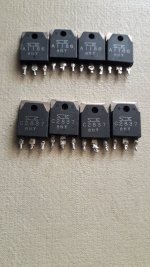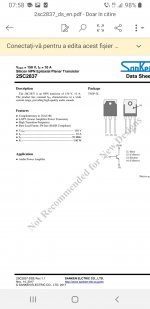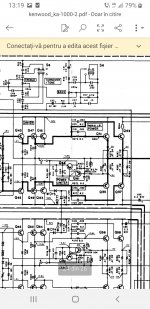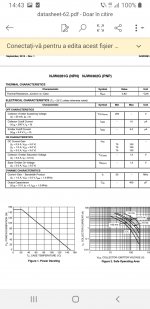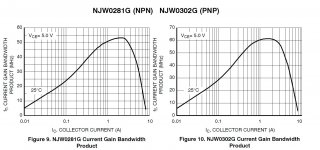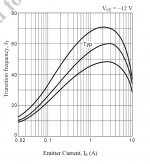Me too.lower cob than sc5200/1943 as I don't need high power or high vce trz for my toys.I used Toshiba 2SC5198/2SA1941 instead of them.
Can I help out with MJL3281 and MJL1302? Not the faintest idea if these can be compared but I have them in numbers?!
Last edited:
6 times higher COB , two times lower FT... most probably 2sc2837 would be the perfect driver for 10 x MJL transistors in a 3EF output configuration. My preffered amp of all times had 2 x 200Mhz paralleled transistors driving 2x 2sc2837 ...I said that before...there was a point in time in the 90's where big FT transistors stopped being produced and kenwood had a last try with the quadrive system to get around the cob problem then simply moved all their high end line to Accuphase which settled on the diamond buffer and current feedback to overcome the crossover with low bias as it was immune to driving high cob , but if you want a simple schematic with good distortion figures at high power output transistors cob can only be overcome if we go back , way back in time to bootstraped drivers yet bootstrapped amplifiers have a nonlinear evolution of thd as bootstrap is not doing its job at low levels so you see 10 times higher distortions at 1watt then what a bootstrapped amp shows at 100watts...which is weird.3EF stages with low cob and high ft transistors can easily achieve unmeasurable thd below -120db at 1watt and below 0.001%thd at 100watts.Can I help out with MJL3281 and MJL1302? Not the faintest idea if these can be compared but I have them in numbers?!
Attachments
Unfortunately we won't be seeing too soon 100 watts 70 mHz transistors driving 150 watts 80 mHz trz...http://e-hifi.pl/index.php?id=31
NJW0xxx can do 55-60MHz at Ic=1-2AUnfortunately we won't be seeing too soon 100 watts 70 mHz transistors driving 150 watts 80 mHz trz...http://e-hifi.pl/index.php?id=31
Which one?NJW0xxx can do 55-60MHz at Ic=1-2A
Attachments
One measurement is done at 5v, the other at 12V...that means double the headroom at high frequency which is normal due to 4 times higher capacitance of the njw transistor, but that also means you need 4 times more current to drive them at just half the headroom and similar bandwidth...Not COOL 🙂
Lower Uce is worse condition. So NJW would be better with 12V Uce. Same for the Cob. It is easy to measure low Cob at 80V Uce...One measurement is done at 5v, the other at 12V...that means double the headroom at high frequency which is normal due to 4 times higher capacitance of the njw transistor, but that also means you need 4 times more current to drive them at just half the headroom and similar bandwidth...Not COOL 🙂
how about 2sa1302/2sc3281? i got some original from an old audio
most of the time i use c5200/a1943
most of the time i use c5200/a1943
no doubt we had some nice, speedy output device choices in the past. so many have said over the years that you can't make money in high end audio. the semiconductor device industry certainly seems to buy into that.
since dreamth threw it out there with that schematic snippet, is it just me or is it rather strange to put such a nice design (KA-1000) in a plastic chassis (!) and separate the power transformers from the amp in such a way?
it seems to be taking the desire for a "non-magnetic" chassis to an extreme at the expense of other design concerns ...
reminds me of the slew rate wars - with the focus on speedy slewing, i think some of those "winners" had undesirable clipping/latching/rail-sticking issues...
since dreamth threw it out there with that schematic snippet, is it just me or is it rather strange to put such a nice design (KA-1000) in a plastic chassis (!) and separate the power transformers from the amp in such a way?
it seems to be taking the desire for a "non-magnetic" chassis to an extreme at the expense of other design concerns ...
reminds me of the slew rate wars - with the focus on speedy slewing, i think some of those "winners" had undesirable clipping/latching/rail-sticking issues...
I talk about that amp anytime i can because I had it and I can only regret selling it.It was the best amp I ever heard.I never touched anything out of the L kensonic -kenwood series which was made by the same engineers and had the same philosophy, but at least I know one amp that was brilliant.It wasn't made out of plastic actually, the plastic and glass was on the faceplate,but the rest of it was just some light metal.Nonmagnetic chassis ment that the transformers were not inside the amp and the main reason for that was to not interfere with the sigma drive circuit at low frequencies.since dreamth threw it out there with that schematic snippet, is it just me or is it rather strange to put such a nice design (KA-1000) in a plastic chassis (!) and separate the power transformers from the amp in such a way?
it seems to be taking the desire for a "non-magnetic" chassis to an extreme at the expense of other design concerns ...
reminds me of the slew rate wars - with the focus on speedy slewing, i think some of those "winners" had undesirable clipping/latching/rail-sticking issues...
At least this amp had a truly technical review in the past so my feelings were backed by measurements too:
http://www.hifi-classic.net/review/kenwood-ka-1000-263.html
I had thd opportunity in 2017 to buy the L-06M monoblocks for 650 pounds all tax and transport included from hifi-do Japan and I hesitated on that which now I also regret as that was the best they ever made and I could never find a schematic although it is said to be somewhat like the l-02M.
interesting writeup you linked to. it did say this "...made the KA-1000 entirely of nonmagnetic materials-aluminum top cover and front panel, molded plastic sides and trim.". i thought it was all plastic.
I agree - I would like to see a schematic of the L-06M, too. Sorry you missed that deal ...
I agree - I would like to see a schematic of the L-06M, too. Sorry you missed that deal ...
@dreamth, be carefully with this tricky amp. there are transis on Board But Not on the Diagramm!!!
Unsolder all semiconductors to measure them. Work for slaves but otherway there might a
Bad surprise on switchon. Arnd dont forget the Board on the backside with the speakerterminals
As there is a saftycircuit.
Good luck
Ingo
Unsolder all semiconductors to measure them. Work for slaves but otherway there might a
Bad surprise on switchon. Arnd dont forget the Board on the backside with the speakerterminals
As there is a saftycircuit.
Good luck
Ingo
???@dreamth, be carefully with this tricky amp. there are transis on Board But Not on the Diagramm!!!
Unsolder all semiconductors to measure them. Work for slaves but otherway there might a
Bad surprise on switchon. Arnd dont forget the Board on the backside with the speakerterminals
As there is a saftycircuit.
Good luck
Ingo
I noticed that Kenwood did not
print the complete circuits in
their servicemanuals. On KA 1000
no korrekt info about the sigma-drive. Just be careful.
Ingo
- Home
- Design & Build
- Parts
- Sad...
